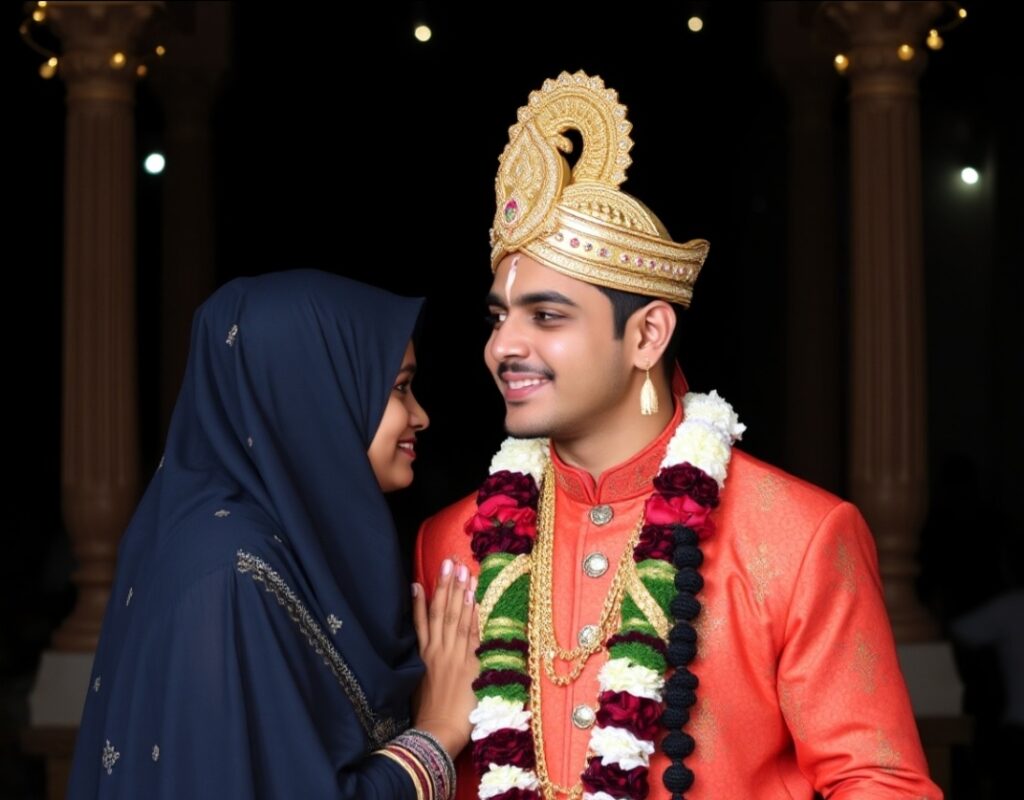Anjali was born into a Muslim family as Aafiya in a small, bustling town. From a young age, she was taught the values of kindness, respect, and devotion. Her parents raised her with love and care, instilling in her the teachings of Islam. Yet, as Anjali grew older, she began to feel a deep yearning for something more. There was an inner curiosity that nudged her to understand the deeper meanings of life, purpose, and spirituality.
During her college years, Anjali became close friends with Raj, a Hindu boy from a neighboring village. Raj was different from others; he was kind-hearted, thoughtful, and always eager to share his perspective on life. Despite coming from different faith backgrounds, the two became inseparable friends. They would spend hours discussing everything from philosophy to literature, often exchanging stories from their respective cultures and religions.
One day, Raj shared with Anjali a small book he cherished: the Bhagavad Gita. “It’s one of the most sacred texts in Hinduism,” he explained, his eyes sparkling with devotion. “It taught me to see beyond the material world and to seek inner peace.” Intrigued, Anjali agreed to read it, though she was cautious, as she had always been deeply rooted in her own faith.
The words of the Bhagavad Gita resonated with her in ways she hadn’t expected. The teachings of Bhagwan Krishna, especially about the eternal soul and the importance of selfless action, struck a chord deep within her heart. The verse, “You are not the body; you are the soul,” was something she had never heard before, and it made her question her previous understanding of existence. She began to see that spirituality transcended the labels of religion—it was about the journey of the soul toward truth and peace.
Anjali continued to study the Gita in secret, exploring its teachings and meditating on them. She was drawn to the idea of living with purpose, embracing one’s duty without attachment to the outcome, and realizing the oneness of all life. The more she read, the more she found herself at peace. It was as if the fog in her heart was clearing, revealing a profound understanding of love, compassion, and the eternal nature of the soul.
Her friendship with Raj deepened. They continued to talk about everything—faith, love, and the mysteries of life. Anjali felt an undeniable connection with Raj, but it wasn’t just because of his kindness. It was his unwavering belief in the divine, his inner peace, and the way he lived by the principles he learned from the Bhagavad Gita.
One day, Raj gently asked, “Anjali, I’ve noticed the changes in you lately. You seem more peaceful, more centered. I’ve always respected your faith, but have you thought about what you truly believe in your heart?”
Anjali looked at him, her eyes full of gratitude. She had been wrestling with her thoughts for some time, but it was in that moment that she found clarity. She realized that her heart had already found its truth in the teachings of the Bhagavad Gita. She believed that the path of righteousness, devotion, and selfless action, which transcended all religions, was the one she wanted to follow.
“I think I have found my truth in the teachings of the Gita,” Anjali said softly. “It’s not about changing religions; it’s about embracing what resonates with my soul.”
Raj smiled warmly, his heart swelling with happiness. “That’s the beauty of life—truth is universal. It unites us, regardless of the path we take.”
As time passed, Anjali’s journey toward spiritual awakening led her to a deeper connection with Raj. The two eventually fell in love, not just with each other, but with the shared wisdom that connected their hearts. They decided to marry, not as a Muslim girl and a Hindu boy, but as two souls who had found truth in their own unique ways. Their marriage was a celebration of unity, not division, and was based on mutual respect, understanding, and love for each other’s beliefs.
Their wedding ceremony took place under traditional Dharmic rituals, marking a significant moment in Anjali’s spiritual journey. Aafiya, her birth name, had embraced Hinduism with the proper rites, undergoing a sacred transformation to become Anjali, devoted to the teachings of the Bhagavad Gita. The ceremony included the sacred fire, the seven vows, and the blessings of elders, symbolizing not only her spiritual rebirth but also the union of two hearts, bound by love, faith, and the shared pursuit of truth. It was a celebration of love, faith, and the deep connection between two souls united in devotion and understanding.
Anjali’s journey was not an easy one. It required courage to question her upbringing, to seek the truth, and to embrace a new way of thinking. But in doing so, she found a deeper sense of purpose and inner peace. Her love for Raj and her newfound understanding of the Bhagavad Gita helped her transcend the limits of religious identity, and she embraced the oneness of all beings.
Together, Anjali and Raj worked to create a life rooted in the timeless values of Hinduism or what we call Sanatan Dharma, embracing love, respect, and devotion to the divine. They built a community that celebrated the teachings of the Bhagavad Gita and the wisdom of ancient Dharmic traditions, understanding that spirituality, when practiced with sincerity, leads to unity with the Divine. Through their love, they demonstrated that the path of righteousness, selfless action, and devotion to God brings peace, harmony, and a deep connection with all of creation. Their journey showed the world that when the heart is open to the eternal truths of Sanatan Dharma, it leads to spiritual fulfillment and universal harmony.

